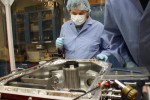Scientists observed the skies through a telescope in the mountains of Chile, spotting what they thought was a trivial dot near a bright star.
They circled the image around speculatively, analyzing it carefully, attempting to eliminate any possibility for mistakes. But what began as a grain of hope was very quickly confirmed to be a planet, much like Jupiter, approximately 100 light years away.
The discovery was made in part by UCLA faculty, graduate students and alumni along with other universities and was published in Science Magazine Thursday.
The planet is named 51 Eridani b and is 20 million years old, said Bruce Macintosh, a UCLA alum and the principal investigator of the project. It is twice the size of Jupiter, with a temperature of about 400 degrees celsius and a little further away from its solar system’s central star as Saturn is from the Sun. Its atmosphere contains a mix of hydrogen, methane and water vapor, he said.
James Larkin, a professor in the UCLA physics and astronomy department and co-author of the study, said the discovery is unique because scientists don’t often find planets and solar systems that are similar to the Milky Way’s. The discovery may give scientists insight on possible planets in other solar systems that may contain life, he said.
Larkin, the principal investigator of the team responsible for the UCLA component of the Gemini Planet Imager – the system with which the discovery was made – said the location of 51 Eridani b and its young age indicates that its solar system may be similar to ours, as opposed to what many other scientists have encountered.
Macintosh said this may give way for other similarities including the development of other planets around 51 Eridani b and potentially an Earth-like planet.
The scientists discovered it through a telescope that used the first Gemini Planet Imager – a system which aims to find solar systems similar to the Milky Way.
Larkin said the infrared spectrograph examines the area round the star and measures the wavelengths of light around it to detect different types of molecules. It then compares them to the brightness of the star. Without the instrument, the telescope would not be able to capture the planet on the screen because the star’s brightness would be too high.
Researchers would take turns traveling to Chile and observing the skies through the telescope, Macintosh said.
Jeffrey Chilcote, a doctoral student in astronomy who graduated from UCLA in 2014, said researchers determined a list of 600 stars that may have potential to foster planets similar to our own.
Each night, the team would decide which star would be best to observe, depending on the time of year, atmospheric conditions and previous observations, he said. Once they chose a star, they spent the night examining the area around it, trying to discern potential planets in the star’s solar system. This was the first time they were successful.
A UC Berkley graduate student first spotted the planet when he saw a small dot on the screen.
“Initially I was skeptical, but very rapidly, it was clear (he discovered a planet) when others repeated the analysis,” Macintosh said.
Larkin said researchers analyzed the images to verify whether what they had seen was really a planet.
Larkin said he recalled working with the Hale Telescope as a graduate student, which was the largest telescope in the world at the time. He said he enjoyed the opportunity to look for answers to profound questions such as the origin of Earth and its inhabitants. Being able to probe further into the unknown inspired his interest in space and the eventual development of the spectrograph.
“That was just really moving to me – that we could go out and take a photo, image something from the very early universe and determine what it’s made of, where we came from and how it all happened,” Larkin said.
He added that he finds the process of developing the new technology that facilitated the sighting addicting.
“If you build a new instrument, you’re usually adding some capability that’s never been there before,” Larkin said.
